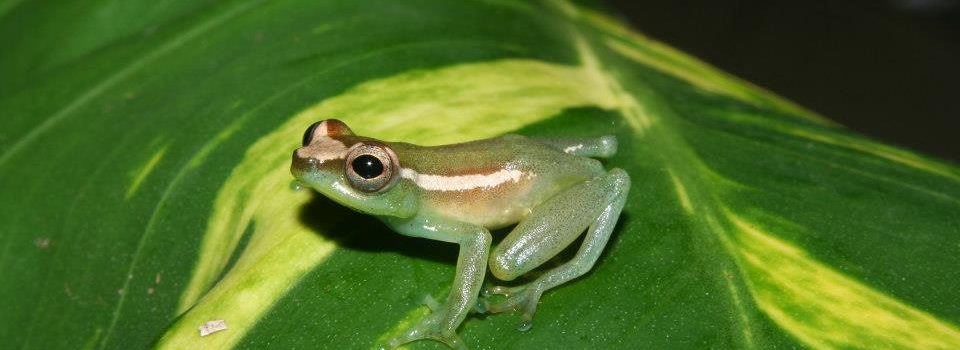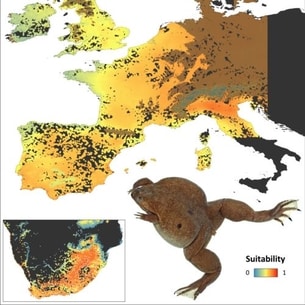PhD defense of Philipp Ginal
Philipp Ginal has just very successfully defended his PhD thesis!
“Invasion biology of amphibians and reptiles: From observations to predictive spatial models”
His thesis entitled “Invasion biology of amphibians and reptiles: From observations to predictive spatial models” comprises six publications. Overall, his thesis is broadly folded, and comprises several target species across different taxonomic groups (i.e., anurans, urodeles, squamates), scales (i.e., local, regional, macro-ecological landscapes), and methodological approaches (i.e., population size estimation, connectivity modeling, correlative and mechanistic species distribution modeling, mechanistic quantification of activity time budgets). The focus of my thesis relies on the methodological approaches and therefore, the red line here starts with relatively simple models and ends with a novel, complex mechanistic approach.
Furthermore, three publications consider the African Clawed Frog, Xenopus laevis (Daudin, 1802), which is among the most invasive amphibian species in the world.
Two further publications focus on the Oriental Garden Lizard, Calotes versicolor (Daudin, 1802) complex, a wide-spread but neglected invader with potential negative impacts, and the Italian Cave Salamander, Speleomantes italicus (Dunn, 1923), which is non-native but locally very restricted with no known negative impacts yet. Another publication considers the invasive fungal disease Batrachochytrium salamandrivorans Martel et al. 2013 (Bsal), which has substantial negative impacts on macro-ecological scales, and one of its host species, the European Fire Salamander, Salamandra salamandra (Linnaeus, 1758).
These papers are already published and included in the thesis:
Ginal, P., N. Kruger, C. Wagener, L. Araspin, M. Mokhatla, J. Secondi, A. Herrel, J. Measey, and D. Rödder. 2023. More time for aliens? Performance shifts lead to increased activity time budgets propelling invasion success. Biological Invasions 25: 267–283. (PDF)
Ginal, P., W. C. Tan, and D. Rödder. 2022. Invasive risk assessment and expansion of the realized niche of the Calotes versicolor species complex (Daudin, 1802). Frontiers of Biogeography 14.3, e54299. (PDF)
Ginal, P., M. Mokhatla, N. Kruger, J. Secondi, A. Herrel, J. Measey, and D. Rödder. 2021. Ecophysiological models for global invaders: Is Europe a big playground for the African clawed frog? Journal of Experimental Zoology – Part A: Ecological and Integrative Physiology 2020: 158-172. (PDF)
Ginal, P. C.-H. Loske, T. Hörren and D. Rödder. 2021. Cave salamanders (Speleomantes spp.) in Germany: tentative species identification, estimation of population size and first insights into an introduced salamander. Herpetology Notes 14: 815-822. (PDF)
Ginal, P., F. D. Moreira, R. Marques, R. Rebelo, and D. Rödder. 2021. Predicting terrestrial dispersal corridors of the invasive African clawed frog Xenopus laevis in Portugal. NeoBiota 64: 103–118. (PDF)
21st European Conference of Herpetology in Belgrad, Serbia
Our group joined the 21st European Conference of Herpetology in Belgrad, Serbia, where our Herpetologists from the LIB, Musem Koenig were very active. We presented five talks and posters! The conference was awesome and the organizers did a very good job. Thank you very much! Here are some impressions and the abstracts.



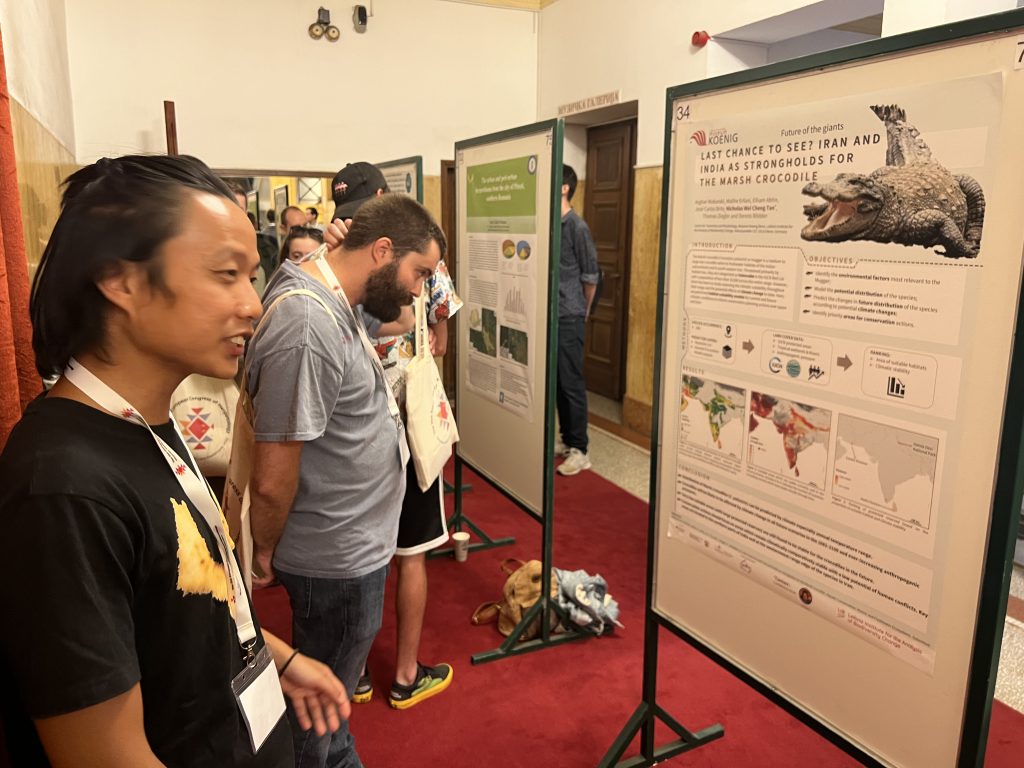
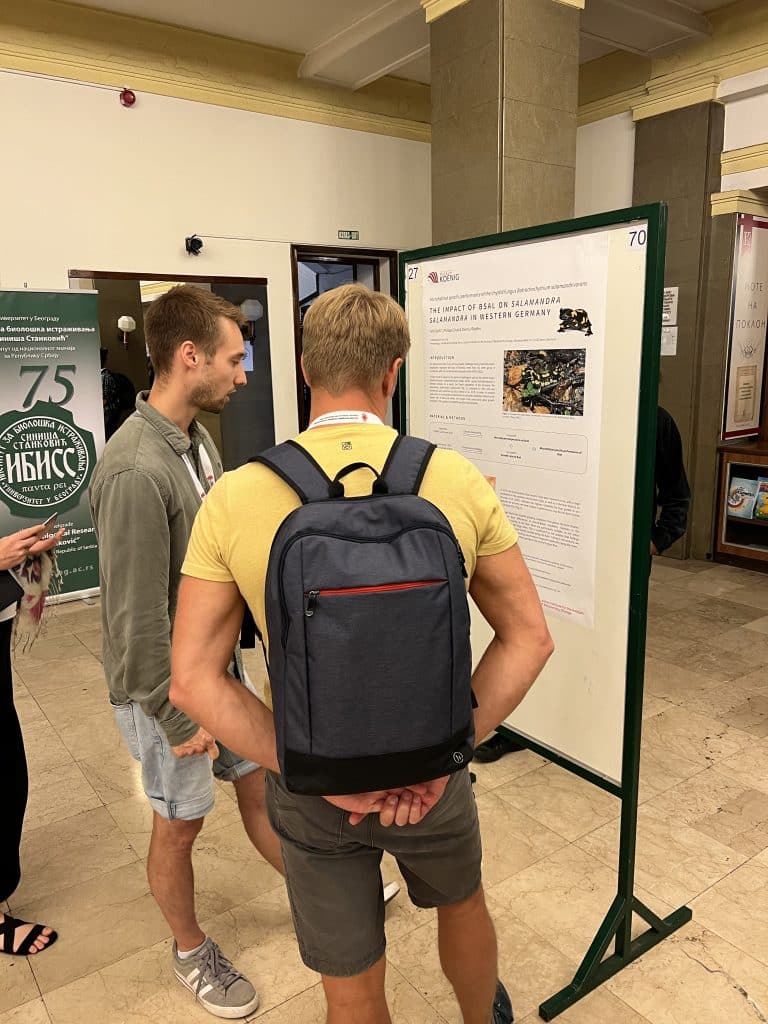








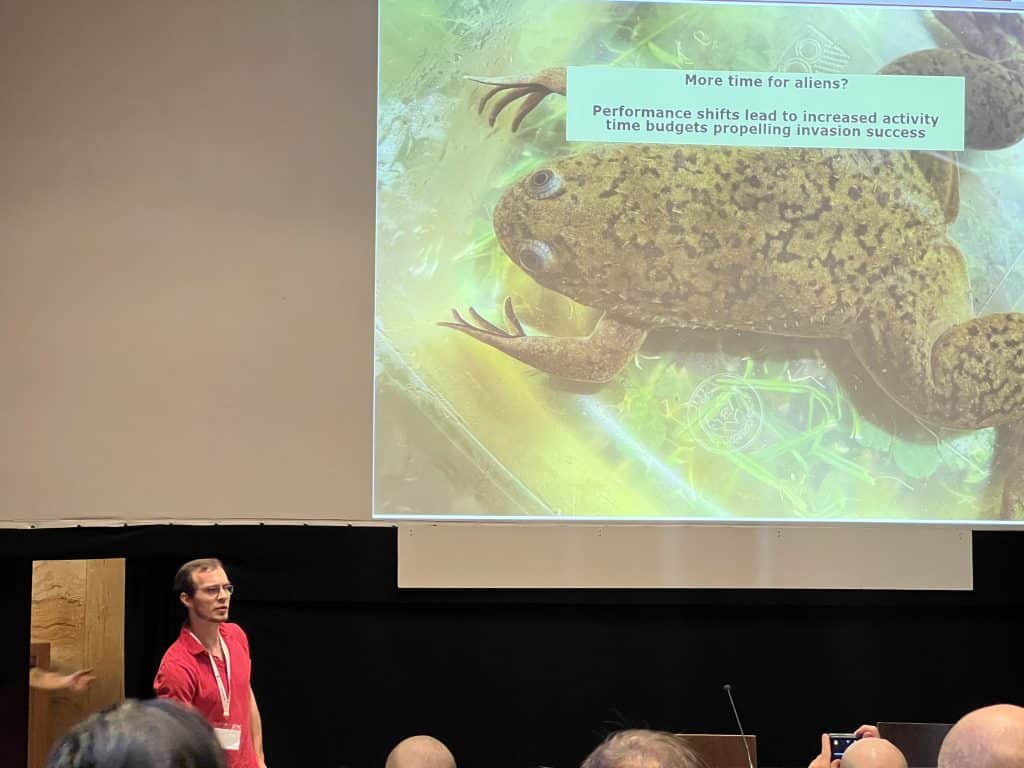
Oral presentation
More time for aliens? Performance shifts lead to increased activity time budgets propelling invasion success
Ginal P.1,*, Kruger N.2,3, Wagener C.2,4, Araspin L.2,5, Mokhatla M.2,6, Secondi J.3,7,
Herrel A.8, Measey J.2, Rödder, D.1
1Zoologisches Forschungsmuseum Alexander Koenig (LIB), Bonn, Germany
2Centre for Invasion Biology, Department of Botany and Zoology, Stellenbosch University, Stellenbosch, South Africa
3Univ. Lyon, Université Claude Bernard Lyon 1, CNRS, ENTPE, UMR 5023 LEHNA, Villeurbanne, France
4Department of Zoology, University of Oxford, UK
5UMR 7179 C.N.RS/M.N.H.N., Département Adaptations du Vivant, Bâtiment d’Anatomie Comparée, Paris, France
6Department of Zoology and Entomology, University of Pretoria, Private Bag x20, Pretoria, Rondevlei Scientific Services, Garden Route National Park, South African National Parks, Sedgefield, South Africa
7Faculté des Sciences, Université d’’Angers, Angers, France
8UMR 7179 C.N.R.S/M.N.H.N., Département Adaptations du Vivant, Bâtim’ent d’Anatomie Comparée, Paris, France
*Corresponding author (e-mail): Philipp Ginal (philipp.ginal@gmx.de)
In the Grinnellian niche concept, the realized niche and potential distribution is characterized as an interplay among the fundamental niche, biotic interactions and geographic accessibility. Climate is one of the main drivers for this concept and is essential to predict a taxon’s distribution. Mechanistic approaches can be useful tools, which use fitness-related aspects like locomotor performance and critical thermal limits to predict the potential distribution of an organism. These mechanistic approaches allow the inclusion key ecological processes like local adaptation and can account for thermal performance traits of different life-history stages. The African Clawed Frog, Xenopus laevis, is a highly invasive species occurring on five continents. The French population is of special interest due to an ongoing expansion for 40 years and a broad base of knowledge. We hypothesize that the French population exhibit increased in activity time in the invasive European range that could be devoted to fitness-relevant activity and (2) tadpoles may have less activity time available than adult frogs from the same range. We investigate how thermal performance traits translate into activity time budgets and how local adaptation and differences in the thermal responses of life-history stages may boost the European Xenopus invasion. We use a mechanistic approach based on generalized additive mixed models (GAMMs), where thermal performance curves were used to predict the hours of activity and to compare the potential activity time budgets for two life-history stages of native and invasive populations. Our results show that adult French frogs have more activity time available in Europe than those in South African frogs, which might be an advantage in searching for prey or escaping from predators. However, French tadpoles do not have more activity time in Europe compared to the native South African populations indicating that tadpoles do not suffer the same strong selective pressure as adult frogs.
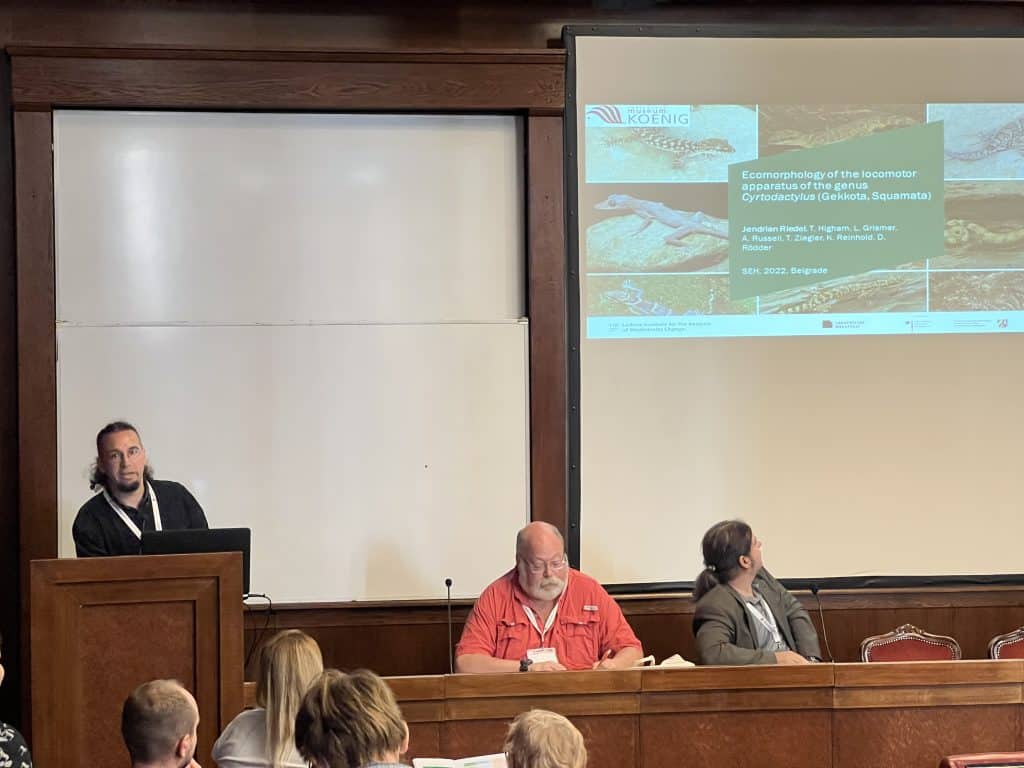
Oral presentation
Ecomorphology of the locomotor apparatus of the genus Cyrtodactylus (Gekkota, Squamata)
Riedel J.1,2,*, Higham T.3, Grismer L.4, Russell A.5, Reinhold K.2, Rödder D.1
1Museum Koenig Bonn – Leibniz Institute for the Analysis of Biodiversity Change, Bonn, Germany
2Department of Evolutionary Biology, Bielefeld University, Bielefeld, Germany
3Department of Evolution, Ecology, and Organismal Biology, University of California, Riverside, CA, USA
4Department of Biology, La Sierra University, Riverside, CA, USA
5Department of Biological Science, University of Calgary, Calgary, Alberta, Canada
*Corresponding author (e-mail): Jendrian Riedel (j.riedel@leibniz.lib.de)
Adaptive radiations, clades of closely related species diversified along one or more morphological and/or ecological niche axes, garner considerable interest from evolutionary biologists. Lizard radiations diversifying along spatial niche space are hypothesised to exhibit distinct changes in body length and relative limb dimensions. One hypothesis predicts that cursorial species have relatively longer hind limbs associated with faster running speeds and relatively shorter forelimbs preventing the latter from interfering with hind limb stride frequency. Accordingly, scansorial species are expected to have relatively shorter limbs, with the fore and hind extremities of more equal length, to promote the maintenance of their center of gravity closer to the substratum. Alternatively, terrestrial species in closed habitats could benefit from relatively shorter limbs because these may reduce their entanglement with more frequently encountered obstacles, whereas scansorial species could benefit from longer limbs which would result in greater limb spans and static stability. Cyrtodactylus is a speciose and ecologically diverse gekkonid genus. From generalist ancestors this clade has repeatedly produced specialists with narrow spatial niches, such as the occupancy of karst formations, caves, granite boulders, and different strata within the arboreal niche. For cave specialists, distinct morphological changes are associated with niche occupancy. The degree of morphological diversification exhibited by the other habitat specialists remains unknown, however. We investigated whether associations exist between limb dimensions and microhabitat use in this genus, to test if either of the opposing hypotheses can be confirmed for this successful radiation. To do so we measured body length and relative limb dimensions in a large sample, including all major lineages, reconstructed the phylomorphospace occupied by the species and tested for associations between spatial niche and limb morphology. We found strong separation between spatial niche groups, although overlap exists particularly among functionally related niches such as those of granite and karst specialists.
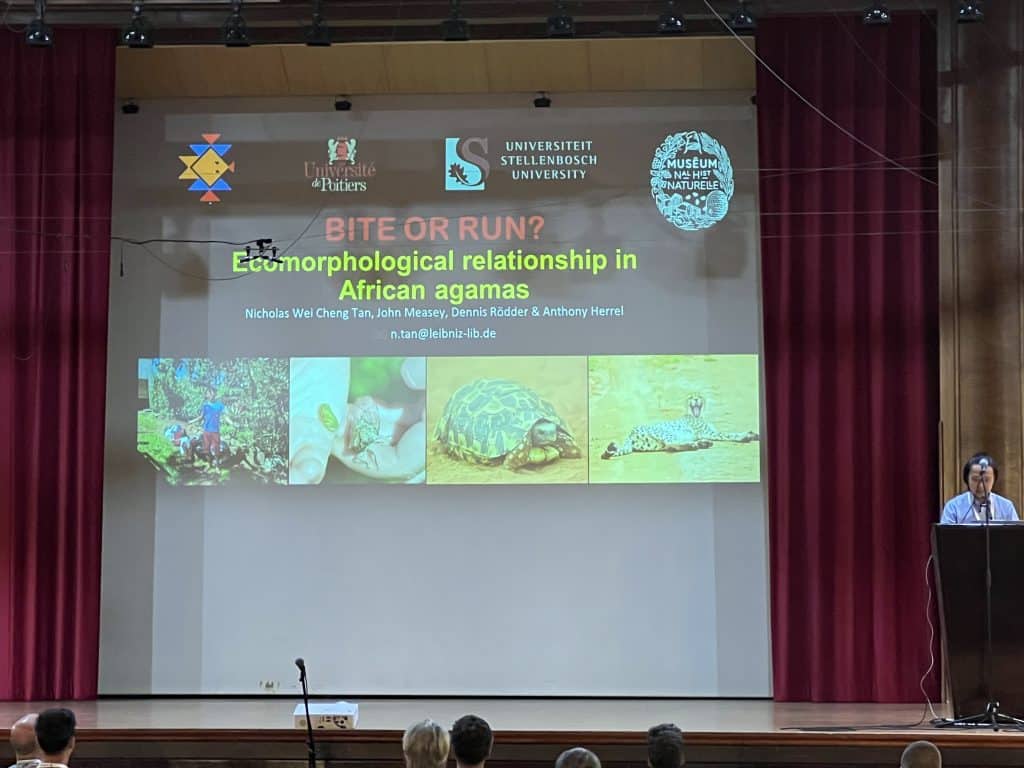
Oral presentation
Bite or run? Ecomorphological relationship in African agamas
Tan N.W.C.1,*, Measey J.2, Vanhooydonck B.3, Herrel A.4
1Herpetology Section, LIB, Museum Koenig, Bonn, Germany
2Centre for Invasion Biology, Department of Botany and Zoology, Stellenbosch University, Stellenbosch, South Africa
3Department of Biology, University of Antwerp, Antwerpen, Belgium
4Département Adaptations du Vivant, UMR 7179 C.N.R.S/M.N.H.N., Bâtiment d’Anatomie Comparée, Paris, France
*Corresponding author (e-mail): Nicholas Wei Cheng Tan (n.tan@leibniz-zfmk.de)
Understanding the relationships between form and function can help us to understand the evolution of phenotypic diversity in different ecological contexts. Many animals display morphological and behavioural adaptations to the habitats in which they live and the resources they exploit. Whole-organism performance traits such as bite force and locomotion are ecologically relevant as they reflect the ability of an organism to include a wider diversity, different or differently sized prey, to escape from predators, or to defend territories. Here, we investigate ecomorphological relationships between diet, morphology, bite force and locomotor performance (sprint speed and endurance) in six species of South African agamids from three habitat types (ground-dwelling, rock-dwelling, and arboreal). Diet analyses showed that ants are a major food source, alongside with active prey such as beetles, wasps and flies. Body and head size are not directly related to diet, although greater in-levers for jaw closing (positively related to bite force) are associated to an increase of hard prey in the diet. Rock-dwelling species have a relatively flatter head than other species, possibly as an adaptation for crevice use. However, even when correcting for jaw length and jaw out-lever length, rock-dwelling species bite harder than ground-dwelling species. Further, endurance capacity of these lizards is correlated with hind limb and toe lengths. Interestingly, however, we demonstrate trade-offs in performance where specialisation towards speed comes at the detriment of endurance. Arboreal species have longer hind limbs, and higher exertion capacity and mean speed. However, for a given hind limb length, they appear to be slower than the other habitat specialists. In sum, our study illustrates the role of morphology in driving functional changes and how habitat use impacts morphology and locomotor performance but not bite force.

Oral presentation
Spatiotemporal patterns of habitat use by the sand lizard (Lacerta agilis Linnaeus, 1758): Effects of climatic seasonality?
Schmitz L.M.1, Clement V.F.1, Edanackaparampil J.1, Ginal P.1, Schluckebier R.1,
Rödder D.1,*
1LIB, Museum Koenig Bonn, Leibniz Institute for the Analysis of Biodiversity Change, Bonn, Germany
*Corresponding author (e-mail): Dennis Rödder (d.roedder@leibniz-lib.de)
The distribution and occurrence of a species in its habitat is inevitably linked with its ecology. To successfully monitor and protect species, it is important to investigate which species-specific factors influence its interactions with the environment. In this study, we focus on patterns in habitat use of the sand lizard (Lacerta agilis). Seasonal as well as sex and age dependent habitat use differences were reported from the species’ range edges. To verify such trends in the core area of its distribution, we analyzed the habitat factors weather, microclimate, microhabitat structures and time dependence, which may have an impact on the behavior of the sand lizard. Using generalized linear models, hypervolumes, density estimations and Chi-squared tests, we found that the movement patterns of the individuals can neither be described by time differences, climatic conditions, or habitat composition, nor do they show habitat or weather-related differences of movement among sexes or age. Here we show that in the case of a population from the core distribution area at the Dellbrücker Heide (Germany), habitat use solely is influenced to a low degree by differences related to ontogeny of the sand lizards and does not depend on any of the other evaluated factors. These results from the core distribution area of the sand lizard show an enormous contrast to findings of populations from peripheral distribution areas, i.e. the United Kingdom, Latvia, Romania, Bulgaria, and the Pyrenees. This implies that seasonal habitats shifts are more extreme at the range edges of L. agilis to compensate deteriorating habitat conditions than in the periphery.
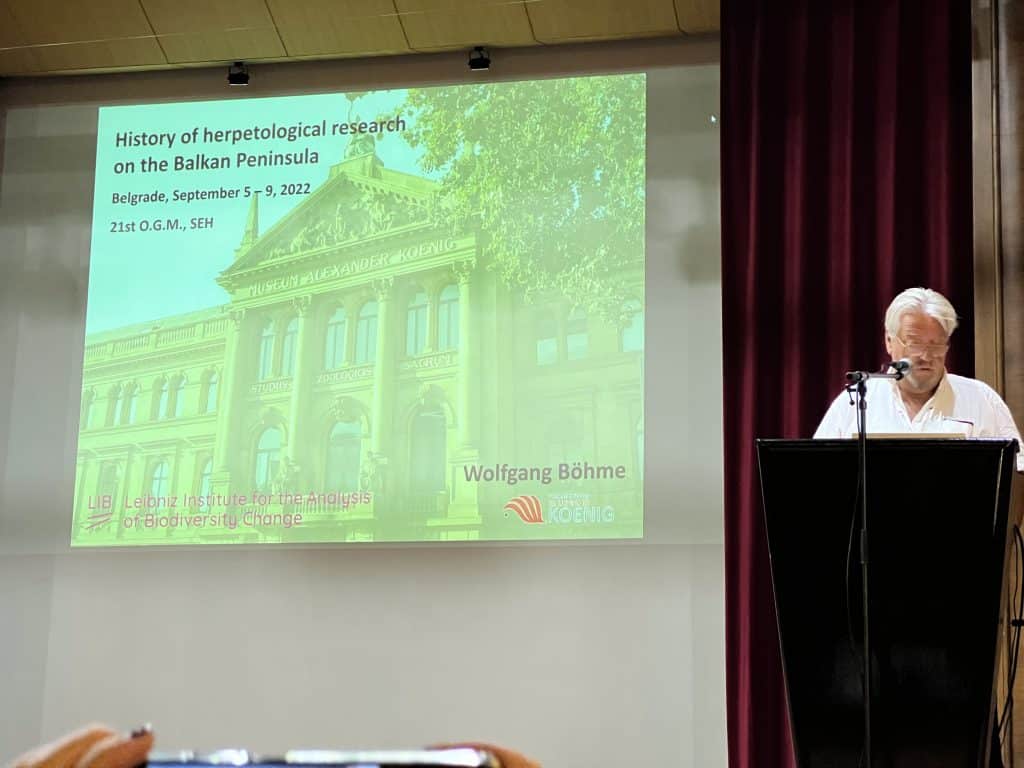
Plenary lecture
History of herpetological research on the Balkan Peninsula
Böhme W.1,*
1Leibniz Institute for the analysis of biodiversity change (LIB) – Museum Koenig, Adenauerallee, Bonn, Germany
*Corresponding author (e-mail): Wolfgang Böhme (w.boehme@leibniz-lib.de)
Southern Europe consists mainly of three large and separate peninsulas shaping the northern coastline of the Mediterranean Sea. Of these, the Iberian peninsula in the west harbours two countries, viz. Portugal and Spain, while the central Apenninian peninsula is made up by just one country, viz. Italy. The Balkan peninsula, in contrast, consists of significantly more countries, including independent states established upon the breakup of former Yugoslavia, then Albania, Bulgaria and Greece. Geographically, as defined by the famous Serbian geographer Jovan Cvijić, also the south of Romania and the European part of Turkey („Turkish Thrace“) have to be added. This historically induced multinational cultural diversity had also great influence on the history of science, including herpetology. The global birthplace and also the name-provider of the term herpetology was Greece and its language, where for instance Aristotle (384-322 BC) wrote an astonishingly exact description of the chameleon while the role of snakes was more a mythological one, nonetheless influential for the entire realm of the Greek-Roman antiquity. But since the origin of modern herpetology by the fundamental work of Carolus Linnaeus, mostly researchers from more northern parts of Europe started to study Balkan herpetology. The lecture will review the main contributors to the herpetology of the Balkan peninsula. They will be discussed countrywise, according to the contemporary geographic delimitations. A focus is laid on the remarkable shift from initially mostly foreign researchers towards autochthonous herpetologists taking care by themselves for the exploration of their respective countries. An overview of the zoogeographical importance of Balkan amphibians and reptiles is given, followed by a summary of important endemic species living in this herpetological diversity hotspot.
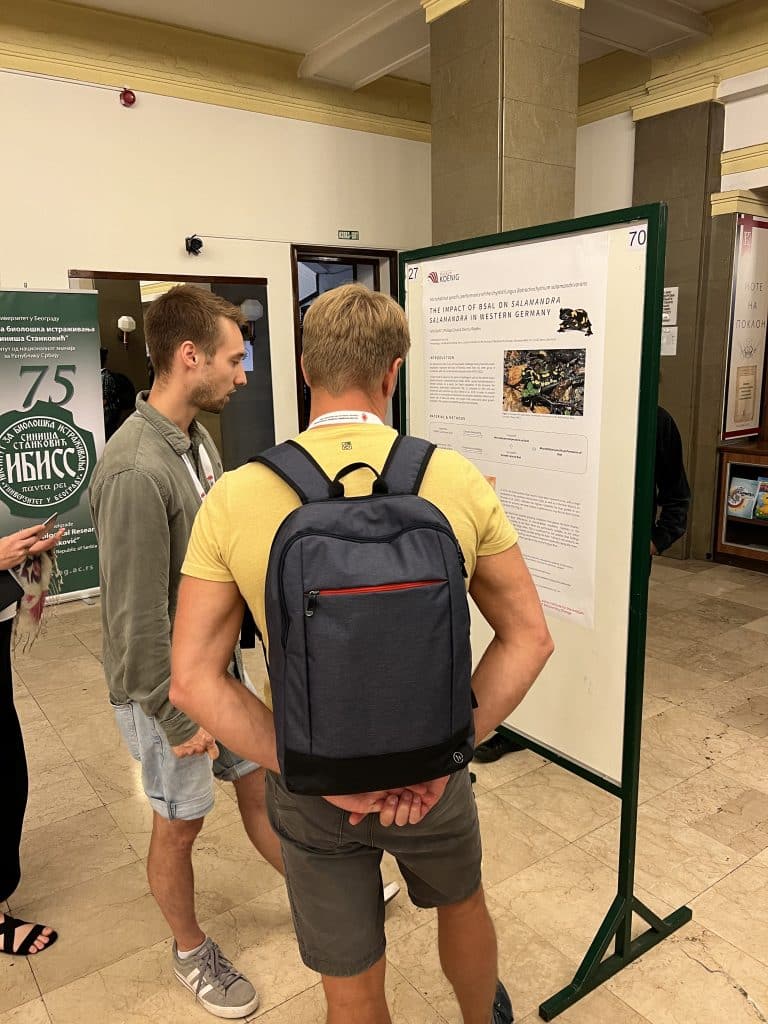
Poster presentation
Microhabitat specific performance of the chytrid fungus Batrachochytrium salamandrivorans and its impact on Salamandra salamandra (Linnaeus, 1758) in western Germany
Deiß F.1,*, Ginal P.1, Rödder D.1
1LIB, Museum Koenig Bonn, Leibniz Institute for the Analysis of Biodiversity Change, Bonn, Germany
*Corresponding author (e-mail): Felix Deiβ (felix@deiss-dv.de)
Nowadays, chytridiomycosis is one of the greatest threats to the diversity of amphibians worldwide. Caused by both, the well-known chytrid fungus Batrachochytrium dendrobatidis (Bd) and the chytrid fungus Batrachochytrium salamandrivorans (Bsal), it plays a decisive role in amphibian declines. The pathogen Bsal, which originally was introduced from Southeast Asia, was discovered in Europe for the first time in 2013. It is particularly harmful to caudate species, as it causes epidermal ulcerations, anorexia and ataxia, which ultimately lead to death in infected animals. As a result it has locally eradicated the formerly common fire salamander Salamandra salamandra in some regions of north-western Europe. In the Netherlands, for example, the fire salamander population has shrunk by 96%. Currently, Germany is the most affected area, with two hotspots: the Ruhr region and the southern Eifel. To simulate the performance of Bsal in its main invasive distribution area, we computed microclimatic surfaces, as temperature has shown to be the most important parameter affecting Bsal. These were simulated based on different habitat types, derived from the most recent Corine Land Cover 2018 maps. Although almost the entire study area would support the growth of Bsal, there are clear differences in the likely performance between different, small-scale environments. Based on these findings, possible Bsal hotspots are identified and recommendations for conservation activities are given
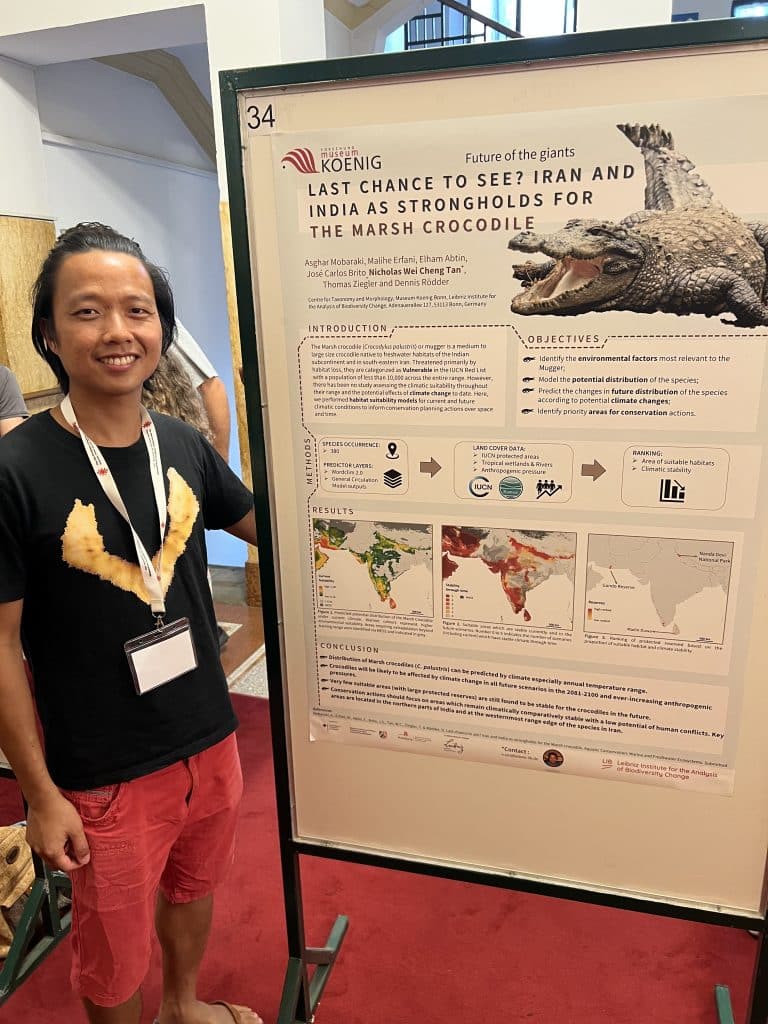
Poster presentation
Last chance to see? Iran and India as strongholds for the Marsh crocodile (Crocodylus palustris)
Mobaraki A.1, Erfani M.2, Abtin E.3, Brito J.C.4,5,6, Tan W.C.7,*, Ziegler T.8, Rödder D.7
1Natural Environment Deputy, Wildlife conservation and management Bureau, Department of Environment, Tehran, Iran
2Department of Environmental Sciences, Faculty of Natural Resources, University of Zabol, Iran
3Natural Environment Division, Department of Environment Office in Sistsan and Baluchestan Province, Zahedan, Iran
4CIBIO, Centro de Investigação em Biodiversidade e Recursos Genéticos, InBIO Laboratório Associado, Campus de Vairão, Universidade do Porto, Portugal
5Departamento de Biologia, Faculdade de Ciências, Universidade do Porto, Portugal
6BIOPOLIS Program in Genomics, Biodiversity and Land Planning, CIBIO, Vairão, Portugal
7Zoologisches Forschungsmuseum Alexander Koenig, Bonn, Germany
8AG Zoologischer Garten Köln, Germany
*Corresponding author (e-mail): Nicholas Wei Cheng Tan (n.tan@leibniz-zfmk.de)
Predictions of future change in species distributions are necessary for defining adequate conservation planning actions over space and time. The Marsh crocodile (Crocodylus palustris) is native to the freshwater habitats of the Indian subcontinent and in south-eastern Iran. Habitat loss is currently the most important factor threatening crocodile dispersal and persistence, and climate change will likely place increasing pressure on populations. This study used ecological niche modelling (Maximum entropy) to predict the current distribution of the species and to project it to future climate conditions. For this purpose, 380 occurrence records were used for model computation and environmental data were obtained from Worldclim 2.0. Averages of eight global circulation model outputs assuming four IPCC6 per story lines in 2081-2100 were used as future ensembles. Furthermore, future possible anthropogenic pressure was quantified using economic growth models. Temperature Annual Range was the climatic variable with highest contribution in the modelling. Presently, the most potential suitable habitats are located in Sri Lanka, south-eastern peninsular of India, tropical moist forest along the west coast of India, border between Nepal and India, and the south coast of Iran and Pakistan. In the future, these suitable habitats are predicted to be further fragmented and to move further inland. Additional threats may arise due to increased human conflicts due to human population growth. Conservation actions should therefore focus on those areas which remain climatically comparatively stable with a low potential of human conflicts. Key areas are located in the northern parts of India and at the westernmost range edge of the species in Iran.
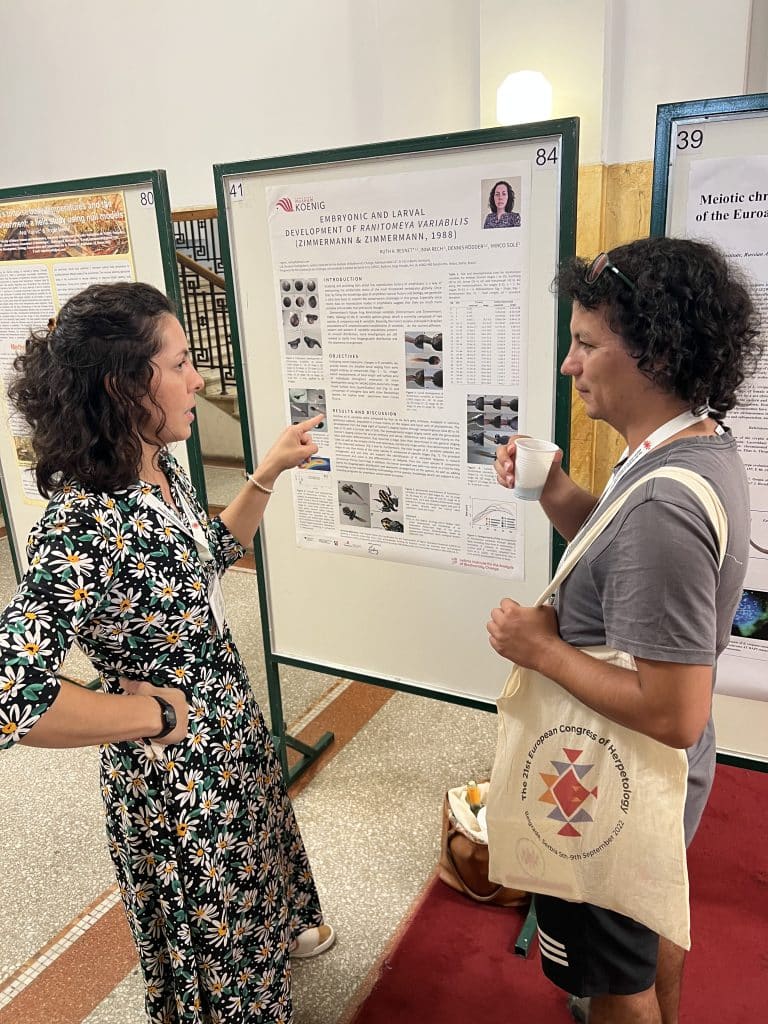
Poster presentation
Captive breeding, embryonic and larval development of the Zimmermann’s poison-frog Ranitomeya variabilis (Zimmermann and Zimmermann, 1988), (Anura: Dendrobatidae)
Regnet R.A.1,2,*, Rech I.1, Rödder D.1,2, Solé M.1,2
1LIB, Museum Koenig Bonn, Leibniz Institute for the Analysis of Biodiversity Change,
Bonn, Germany
2Programa de Pós Graduação em Zoologia, Universidade Estadual de Santa Cruz – (UESC), Salobrinho, Ilhéus, Bahia, Brazil
*Corresponding author (e-mail): Ruth Anastasia Regnet (regnet_ruth@hotmail.com)
Following recent taxonomic changes in Ranitomeya variabilis (Zimmermann and Zimmermann, 1988), we provide herein, for captive bred specimens from French Guiana a description of husbandry in captivity; image-based measurements of total length (TOL) and surface area of individuals throughout embryonic to larval development using the SAISAQ (Semi-Automatic Image based Surface Area Quantification) tool. Furthermore, we provide a detailed larval staging from early staged embryo to metamorph. Clutches of R. variabilis were composed of four to six dark grey eggs, deposited in a mass and wrapped in a colorless gelatinous capsule. Deposition occurs mainly on the largest and basal axils of phytotelma, and less often in photographic film containers, offered as artificial phytotelma. The obtained growth data by SAISAQ showed in comparison with SAISAQ data of other Ranitomeya species a similar growth pattern. However, we noted a remarkable TOL difference between R. variabilis and other Ranitomeya tadpoles, which was also traceable in the ontogenetic data. The developmental stages largely corroborate with the generalized Gosner’s staging system for anuran embryos and larvae. Development from stage eight of Gosner through metamorphosis took 80 to 91 days, with a survival rate of 54%. Differences were observed mainly on the labia and teeth differentiation, which occurred a stage later than expected in the general staging system. As well as, the atrophy of the oral apparatus, which started one stage earlier than expected in two tadpoles. The provided data brings new knowledge about the reproductive biology of this species and supports in situ breeding programs for conservation purposes. We are confident that these data can support the identification of R. variabilis tadpoles in natural environment and the differentiation of tadpoles from the sister species R. amazonica. As well as, providing new data, that can help to clarify the biogeographic distribution and taxonomic arrangement of the species.

Poster presentation
Niche differentiation in the relict, endemic spiny frogs Allopaa hazarensis and Chrysopaa sternosignata
Hofmann S.1,*, Masroor R.2, Litvintchuk S.3, Vershinin V.4, Jablonski D.5
1Museum Koenig Bonn, LIB – Leibniz Institute for the Analysis of Biodiversity Change, Bonn, Germany
2Pakistan Museum of Natural History, Garden Avenue, Shakarparian, Islamabad, Pakistan
3Institute of Cytology, Russian Academy of Sciences, St. Petersburg, Russia
4Institute of Plant and Animal Ecology, Russian Academy of Sciences, Ekaterinburg, Russia
5Comenius University in Bratislava, Bratislava, Slovakia
*Corresponding author (e-mail): Sylvia Hofmann (s.hofmann@leibniz-zfmk.de)
The relict, endemic taxa Allopaa and Chrysopaa are key elements of the Hindu Kush-Himalayan amphibian fauna and share an early-Miocene evolution, making them important proxies for the reconstruction of the Paleogene history of the Tibetan Plateau and the evaluation of respective modern scenarios of the development of the HTO. However, there is no much information on the distribution of these taxa. We here provide species distribution models for both taxa and test the hypotheses of niche differentiation. The average performance of our MaxEnt models was considered significantly better than random. They show, that both taxa are geographically separated with an allopatric distribution pattern, and that BIO8 (mean temperature of wettest quarter) was most important to the models. Further, our findings provide strong support for distinct niche divergence among C. sternosignata and A. hazarensis. The study contributes to the knowledge about the distribution of these species and provide basic information for guiding future management of them.
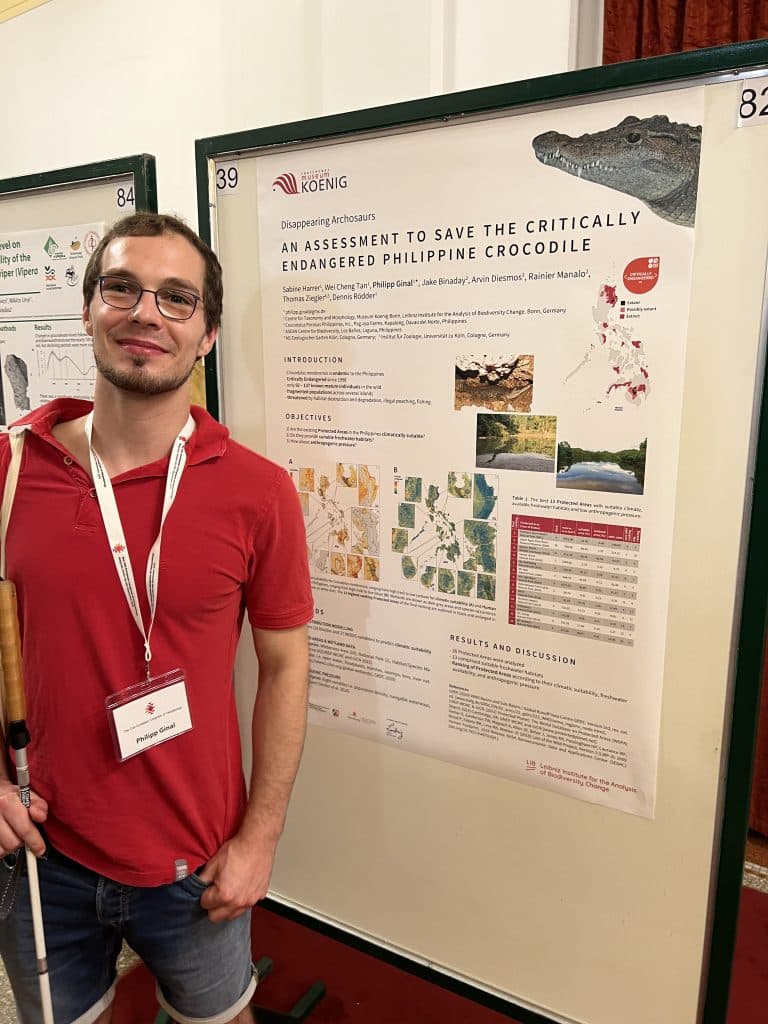
Poster presentation
Disappearing archosaurs – an assessment of established protected areas in the Philippines to save the Critically Endangered and endemic philippine crocodile Crocodylus mindorensis
Harrer S.1, Tan W.C.1, Ginal P.1,*, Binaday J.1, Diesmos A.1, Manalo R.1, Ziegler T.2,3,
Rödder D.1
1LIB, Museum Koenig Bonn, Bonn, Germany
2AG Zoologischer Garten Köln, Köln, Germany
3Institut für Zoologie, Universität zu Köln, Köln, Germany
*Corresponding author (e-mail): Philipp Ginal (philipp.ginal@gmx.de)
Once distributed all over the Philippines, the endemic Philippine Crocodile Crocodylus mindorensis is threatened with extinction. Less than 140 mature individuals live in the wild. Human activities like fishing and illegal poaching, as well as land-use change and habitat conversion cause a continuing threat for the remaining populations. Therefore, designated protected areas were evaluated with species distribution models (SDMs) for improved future conservation efforts. For this purpose, the existing IUCN-reserves were analysed for climatical suitability (combining bioclimatic and remote sensing variables), wetland occurrences and the human footprint index by using MaxEnt and QGIS. Based on topical species records, our final SDM-model showed high performance and revealed the climatically most suitable areas on Luzon and Mindanao. However, only small parts of the climatically optimal area and suitable wetlands are currently covered by reserves. Case in addition, none of the species’ records is located within a protected area. The anthropogenic pressures in the reserves were diverse and varied between a low and moderate level. Most of the records are found in areas with a moderate to medium human footprint. Considering the three criteria, only ‘Northern Sierra Natural Park’, ‘Agusan Marsh Wildlife Sanctuary’ and ‘Upper Agno River Basin Resource Reserve’ revealed to be suitable conservation areas for C. mindorensis. The other reserves seemed to be unsuitable, whereas suitable areas outside protected areas are highly recommended for further surveys. Therefore, the current network of existing protected areas needs significant improvement to provide well-suited and long-term protection for C. mindorensis. More surveys are also necessary to find hidden, so far overlooked populations and verify C. mindorensis tolerance level for human footprint.
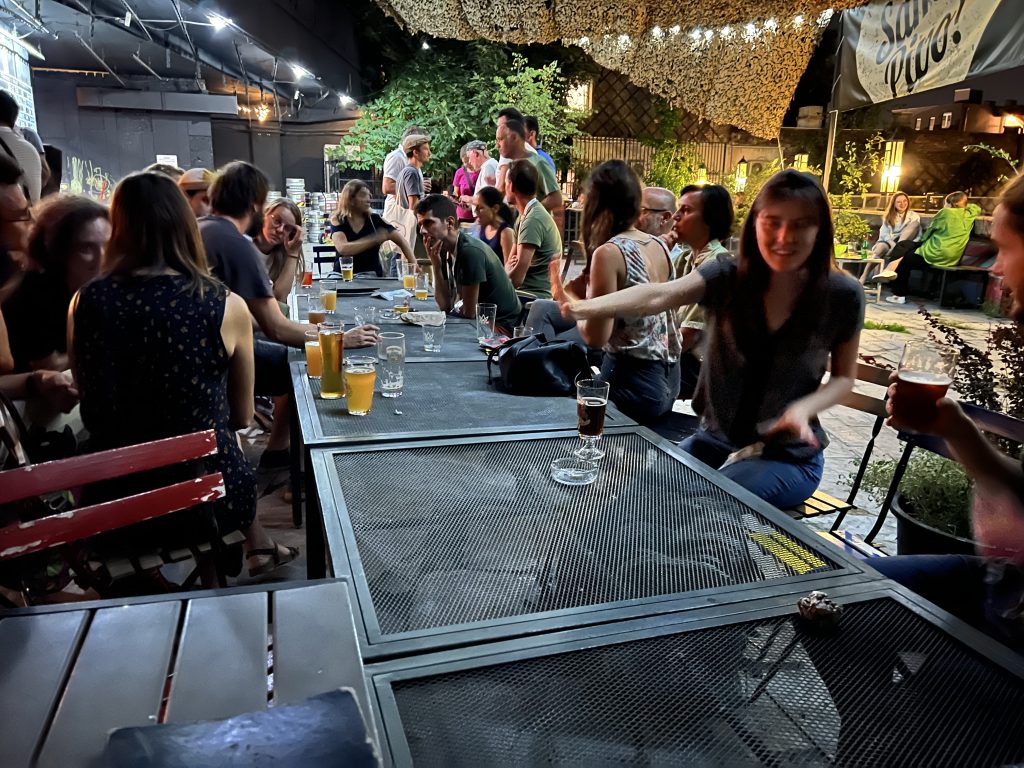

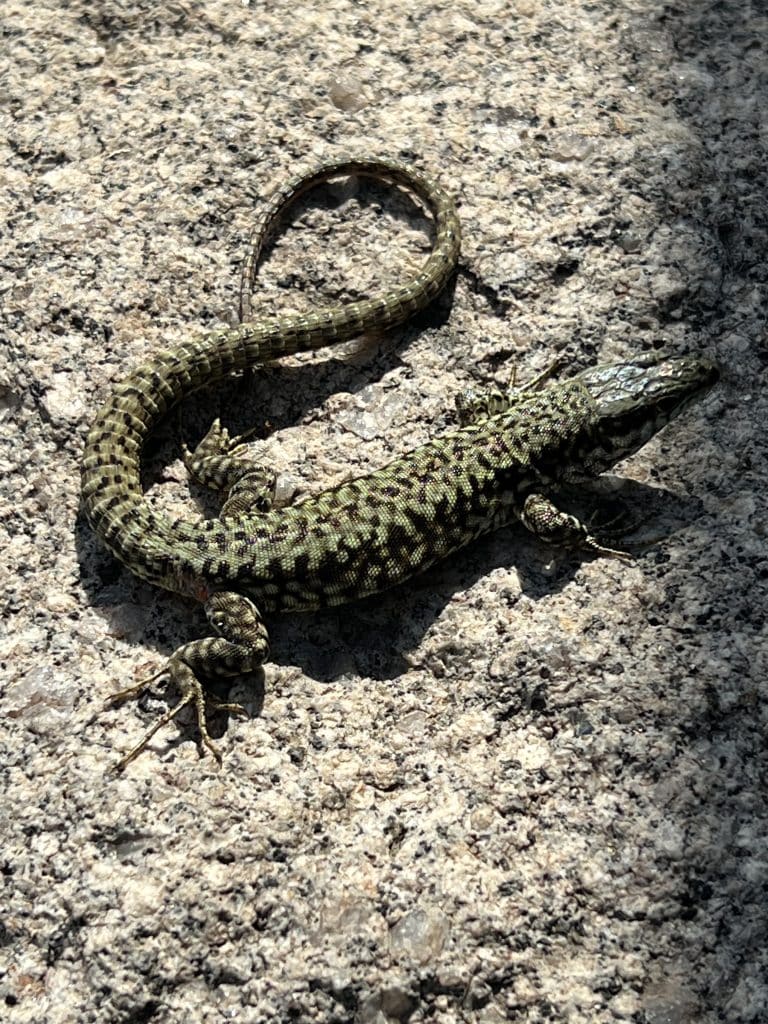













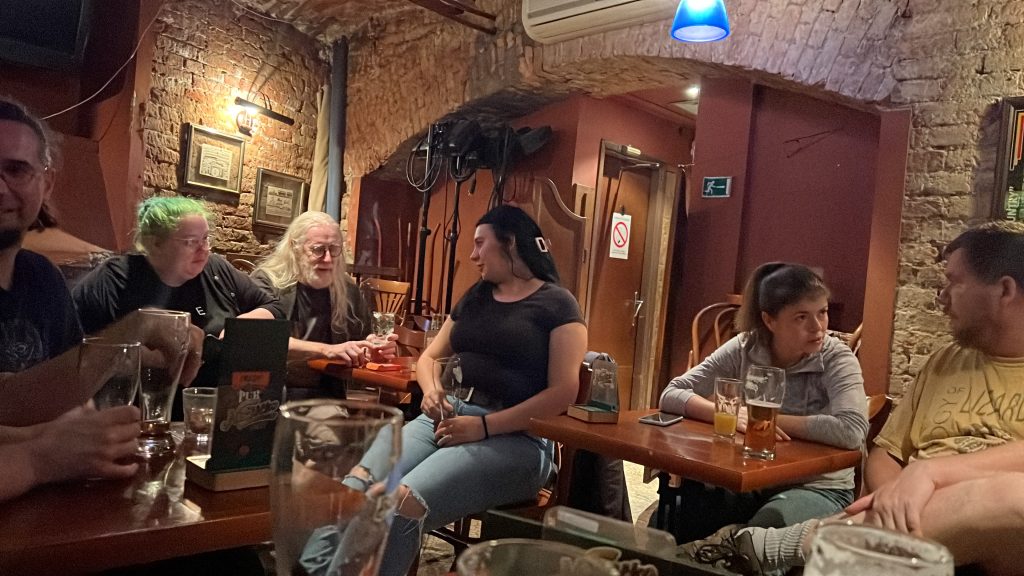



In the realm of fungi – a pathogen leads to mass death
Learn more about the history of emerging pathogens in amphibians in our recent podcast (in german). This time the Pandemia team is not dealing with a virus or a bacterium, but with a fungus: Batrachochytrium dendrobatidis. This pathogen has led to a worldwide mass extinction of amphibians in the last few decades. Australian researcher Lee Berger tells how she discovered the pathogen in the 1990s and why it was initially ignored. Herpetologists Ben Scheele and Dennis Rödder explain how the fungus could spread and what that has to do with an early pregnancy test.
Italian Cave Salamanders in Germany?
Non-native species are among the main factors for the loss of biodiversity. For amphibians, especially some frogs and toads (i.e. Cane Toad or African Clawed Frog) have strong negative impact on ecosystems where these species do not belong. In contrast, only few cases are known where salamanders or newts were found in non-native ecosystems.
Cave Salamanders of the genus Speleomantes are endemic to France and Italy, with three species occurring across the Apennine mountain chain on the European mainland and five species on Sardinia. The common name Cave Salamanders is misleading as members of this genus are no obligate cave dwellers. However, Speleomantes are often found in caves but also in other habitats such as mines or crevices, where a moist and cold environment is provided over the whole year. These environmental conditions are necessary for efficient cutaneous respiration as Cave Salamanders are lungless. Since 2013, it is known that an introduced population of Cave Salamanders occur in the Weserbergland/Solling, Lower Saxony, Germany.
However, the identification of Speleomantes based on morphology is difficult and thus the identity of the German population was unknown and studies were lacking. Further, it was unclear if the German population is composed of just a few individuals that persist there for some years or if it is a reproducing, established population. For this reason, the Biologists Philipp Ginal (Zoological Research Museum Koenig in Bonn) and Carl-Henning Loske (Engineer Office Loske) visited the study area several times to collect and photograph the Cave Salamanders. On six capture events during the autumn of last year, the scientists found 70 different individuals of salamanders with only three individuals captured twice. Together with the colleagues Dennis Rödder (Zoological Research Museum Koenig in Bonn) and Thomas Hörren (University of Duisburg-Essen), capture-recapture models were calculated to estimate the population size.
As Cave Salamanders have a unique color pattern when they are adult, an individual identification is possible. Further, a recently published photographic database, comprising more than 1000 images of all eight Cave Salamander species, was used to give a tentative species identification of the German population. Our capture-recapture models estimate a population size between 170 and 485 individuals. Our results show that the German population is much larger than previously expected. However, the minimum estimate of 170 individuals is very unlikely and more realistically the population is much larger than this estimate. Additionally, we found that morphologically only some populations of the species S. italicus were identical to the German population. S. italicus is native to the northern and central Apennines.
Our tentative species identification was already proofed by genetic analyses of colleagues from the University Braunschweig. Further during field work, we could find juvenile Cave Salamanders as well as a pregnant female, which provides evidence for a reproducing population of Cave Salamanders in Germany. As Cave Salamanders are not native in Germany, future monitoring of the German population is required. However, yet the population seems to be restricted to a single rock scarp of c. 40 m length and negative impacts on the native fauna as well as concurrence with other amphibian species could not be observed yet. Sometimes the Cave Salamandes found together with the native Fire Salamanders or Alpine Newts in the same crevices.
Original publication:
Ginal, P., Loske, C. H., Hörren, T., & Rödder, D. (2021). Cave salamanders (Speleomantes spp.) in Germany: tentative species identification, estimation of population size and first insights into an introduced salamander. Herpetology Notes, 14, 815-822.
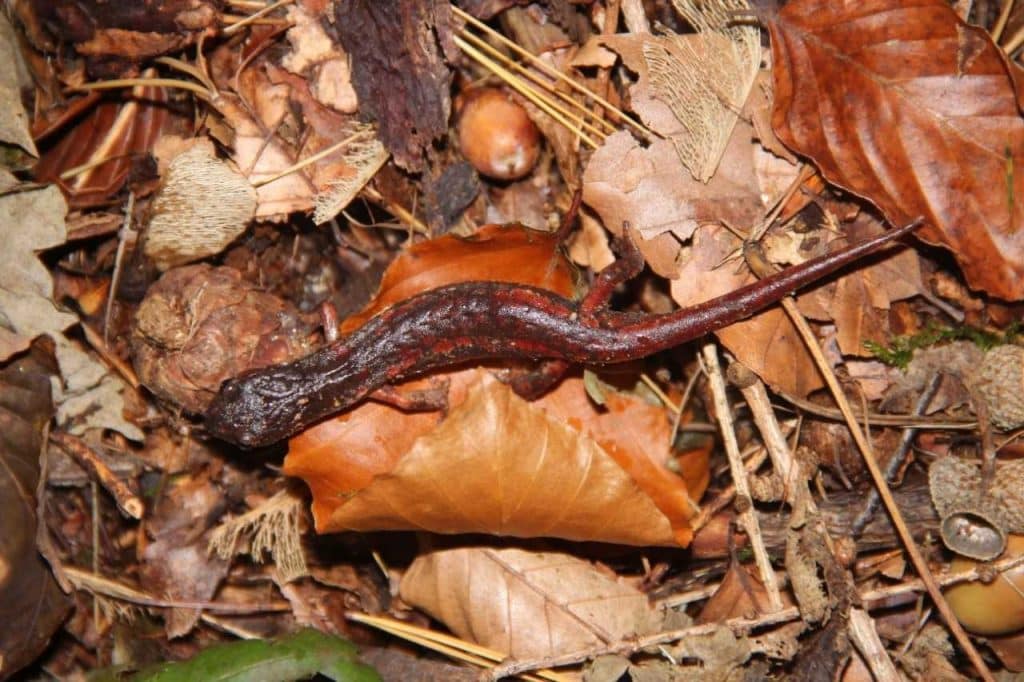
Caption: A specimen of the small population of cave salamanders in Weserbergland/Solling, Lower Saxony The animals have now been determined as Speleomantes italicus by genetic evidence and external appearance. How the species arrived at this location remains unknown.
Mögliche invasive Bedrohung durch den Afrikanischen Krallenfrosch wesentlich größer als gedacht – – mechanistische Modelle im Kampf gegen die unerwünschten Auswirkungen einzelner, verschleppter Arten
21.01.2021 Ein internationales Forscherteam um die beiden Herpetologen Philipp Ginal und Dennis Rödder vom Zoologischen Forschungsmuseum Koenig – Leibniz-Institut für Biodiversität der Tiere (ZFMK, Museum Koenig) nutzen einen neuen Ansatz zur Abschätzung des invasiven Potenzials einer Art. In einem ganz neuen Licht muss danach die Bewertung des Invasionsrisikos des Krallenfroschs gesehen werden. Die neue Berechnung weist in Europa ein Gebiet von fast zwei Millionen km2 möglichen Lebensraums für den Afrikanischen Krallenfrosch aus. Das ist etwa das Doppelte der Fläche, die man bisher angenommen hatte. Die Gefahr, dass die Art nicht ursprüngliche Heimatgebiete massiv negativ beeinflussen wird, ist also wesentlich größer als bisher gedacht. Hinzu kommt, dass es auch schon erste Anzeichen gibt, dass sich in Frankreich eingeschleppte Tiere bereits an das dortige Klima anzupassen beginnen und stark auf dem Vormarsch sind. Das mechanistische Model wurde jetzt im Journal of Experimental Zoology Part A: Ecological and Integrative Physiology beschrieben.
Der Afrikanische Krallenfrosch, Xenopus laevis, stammt ursprünglich aus dem südlichen Afrika. Die Art wurde in der Vergangenheit als Schwangerschaftstest und Modelorganismus für verschiedene Forschungsbereiche genutzt, was dafür sorgte, dass entkommene oder ausgesetzte Krallenfrösche invasive Populationen auf vier weiteren Kontinenten etablieren konnten. Mittlerweile gibt es sogar mehrere Populationen in Frankreich, Italien und Portugal. In den dortigen Ländern richtet die nicht-einheimische Art als Nahrungskonkurrent und Fressfeind großen Schaden an den dortigen Ökosystemen an. Zudem gilt der Krallenfrosch als Überträger des für Amphibien tödlichen Chytridpilzes (Batrachochytrium dendrobatidis), der neben der Habitatzerstörung einer der Hauptursachen des weltweiten Amphibiensterbens ist.
Eine Möglichkeit um das Risiko des invasiven Potenzials nicht-einheimischer Arten, die sich rasch ausbreiten können, abzuschätzen, ist das sogenannte Species Distribution Modelling, auch SDM genannt. Durch diese mathematischen Modelle kann vorhergesagt werden, welche geographischen Gebiete sich auf Grund der Umweltbedingungen für eine Art theoretisch eignen. Bisherige SDMs für den Afrikanischen Krallenfrosch haben jedoch nur einen Bruchteil der klimatischen Nische des Froschlurchs erfasst und somit nicht alle Gebiete, die klimatisch für die Art geeignet sind, vorhergesagt. Nun hat ein internationales Forscherteam um die beiden Herpetologen Philipp Ginal und Dennis Rödder vom Zoologischen Forschungsmuseum Koenig in Bonn im Rahmen des von BiodivERsA und durch die DFG geförderten INVAXEN-Projekts einen neuen Ansatz verwendet. „Mit unserem neuen Ansatz konnten wir durch Laborversuche die kritischen Minimal- und Maximal-, sowie Optimaltemperaturen ermittelt, unter denen der Frosch überleben kann“ erläutert Ginal die neue Vorgehensweise. Unter Berücksichtigung dieser physiologischen Eigenschaften wurde dann die potenziell mögliche Verbreitung in Europa vorhergesagt.
Mit Hilfe dieser sogenannten mechanistischen SDMs lässt sich die zukünftig prinzipiell mögliche Verbreitung einer Art genauer vorhersagen als mit den vorher verwendeten Methoden. „Durch den innovativen methodischen Ansatz war es sogar möglich die physiologischen Limits verschiedener Entwicklungsstadien, wie Kaulquappen und erwachsene Frösche, in das Model einzuspeisen, was vorher ebenfalls nicht möglich war“ legt Rödder dar. Die Ergebnisse der Studie von Ginal et al. (2020) zeigen, dass allein in Europa ein Gebiet von fast zwei Millionen km2 für den Afrikanischen Krallenfrosch geeignet ist. Die vorherigen Methodenansätze hatten dagegen lediglich maximal die Hälfte der Fläche vermuten lassen. Insbesondere Süd- und Westeuropa sind laut den Modellen der Forscher besonders gut für den Frosch geeignet. Aber auch vereinzelte Gebiete in Deutschland scheinen dem Klima des Froschs zu entsprechen.
Dies wirft ein ganz neues Licht auf die Bewertung des Invasionsrisikos des Krallenfroschs, berücksichtigt man, dass es auch schon die ersten Anzeichen gibt, dass sich die in Frankreich eingeschleppten Tiere bereits an das dortige Klima anzupassen beginnen und stark auf dem Vormarsch sind. In zukünftigen Studien planen die Forscher die Auswirkungen der lokalen Anpassung an das europäische Klima zu untersuchen, um weitere Erkenntnisse über den Afrikanischen Krallenfrosch in Europa zu sammeln und so den höchst invasiven Froschlurch von seinem Vormarsch abzuhalten.
Bildunterschrift: Rund zwei Millionen km2 sind als potenziell mögliches Habitat für den Afrikanischen Krallenfrosch in Europa vorhergesagt (Abb. oben). Zur Überprüfung der Korrektheit der mechanistischen Modelle haben die Forscher auch die Verbreitung der Art in ihrem natürlichen Lebensraum im südlichen Afrika korrekt vorhergesagt (in der Abbildung unten links).
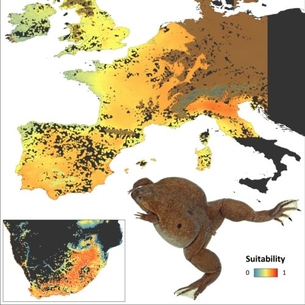
Literatur: Ginal, P., Mokhatla, M., Kruger, N., Secondi, J., Herrel, A., Measey, J., & Rödder, D. (2020). Ecophysiological models for global invaders: Is Europe a big playground for the African clawed frog?. Journal of Experimental Zoology Part A: Ecological and Integrative Physiology.
Predicting terrestrial dispersal corridors of the invasive African clawed frog Xenopus laevis in Portugal
Invasive species such as the African Clawed Frog, Xenopus laevis, are a main threat to global biodiversity. Xenopus is native to Southern Africa but was introduced to four other continents. In Europe, the species could establish populations in France, Italy and Portugal. In our recently published study, we provide a novel approach, which was used to reconstruct the invasion of this highly invasive frog for Portugal. Using satellite data, including data on elevation, vegetation and land cover, we found that this almost fully aquatic frog most likely used a terrestrial corridor with three golf course ponds next to Laje River to reach a second river. Further, we give recommendations about possible future corridors, which will support the Portuguese eradication program for this frog.
Ginal, P., F. D. Moreira, R. Marques, R. Rebelo, and D. Rödder. 2021. Predicting terrestrial dispersal corridors of the invasive African clawed frog Xenopus laevis in Portugal. NeoBiota 64: 103–118.



